Octatonic scale
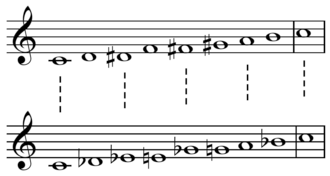
An octatonic scale is any eight-note musical scale. The scale most often meant by this term is one in which the notes ascend in alternating intervals of a whole step and a half step, creating a symmetric scale. In classical theory, in contradistinction to jazz theory, this scale is commonly simply called the octatonic scale (or octatonic collection), although there are in total forty-two non-enharmonically equivalent, non-transpositionally equivalent eight-tone sets possible.
In St. Petersburg at the turn of the 20th century, this scale had become so familiar in the circle of composers around Nikolai Rimsky-Korsakov that it was referred to there as the Korsakovian scale (Корсаковская гамма) (Taruskin 1985, 132). As early as 1911 the Russian theorist Boleslav Yavorsky described this collection of pitches as the diminished mode (уменьшённый лад), because of the stable way the diminished fifth functions in it (Taruskin 1985, 111–13, citing Yavorsky 1911), and in jazz theory it is called the diminished scale (Campbell 2001, 126), or symmetric diminished scale (Hatfield 2005, 125), because it can be conceived as a combination of two interlocking diminished seventh chords, just as the augmented scale can be conceived as a combination of two interlocking augmented triads. In more recent Russian theory the term "octatonic" is not used. Instead this scale is placed among other symmetrical modes (total 11) under its historical name Rimsky-Korsakov scale, or Rimsky-Korsakov mode (Kholopov 1982, 30; Kholopov 2003, 227). Because it was associated in the early 20th century with the Dutch composer Willem Pijper, in the Netherlands it is called the Pijper scale (Taruskin 1985, 73).
The earliest systematic treatment of the octatonic scale was Edmond de Polignac's unpublished treatise, "Etude sur les successions alternantes de tons et demi-tons (Et sur la gamme dite majeure-mineure)" from c. 1879 (Kahan 2009, ), which preceded Vito Frazzi's Scale alternate per pianoforte of 1930 by a full half-century (Sanguinetti 1993, ). The term octatonic pitch collection was first introduced into English by Arthur Berger in 1963 (Van den Toorn 1983, ).
Construction and enumeration
The twelve tones of the chromatic scale are covered by three disjoint diminished seventh chords. The notes from two such seventh-chords combination form an octatonic collection. Because there are three ways to select two from three, there are three octatonic scales in the twelve-tone system.
Each octatonic scale has exactly two modes: the first begins its ascent with a whole step between its first two notes, while the second begins its ascent with a half step (semitone).
Each of the three distinct scales can form differently named scales with the same sequence of tones by starting at a different point in the scale. With alternative starting points listed in parentheses, the three are:
- E♭ diminished (F♯/G♭, A, C diminished): E♭, F, F♯, G♯, A, B, C, D, E♭
- D diminished (F, A♭, B diminished): D, E, F, G, A♭, B♭, B, C♯, D
- D♭ diminished (E, G, B♭ diminished): D♭, E♭, E, F♯, G, A, B♭, C, D♭
It may also be represented as 0134679t or labeled as set class 8-28 (Schuijer 2008, 109).
The three octatonic collections are transpositionally and inversionally symmetric—they are related by a variety of transposition and inversion operations:
They are each closed under transpositions by 3, 6, or 9 semitones. A transposition by 1, 4, 7, or 10 semitones will transform the E♭ scale into the D♭ scale, the D♭ scale into the D scale, and the D scale into the E♭ scale. Conversely, transpositions by 2, 5, 8, or 11 semitones acts in the reverse way; the E♭ scale goes to the D scale, D to D♭ and D♭ to E♭. Thus, the set of transpositions acts on the set of diminished collections as the integers modulo 3. If the transposition is congruent to 0 mod 3 the pitch collection is unchanged and the transpositions by 1 semitone or by 2 semitones are inverse to one another.
The E♭ and D♭ collections can be swapped by inversions around E♭, F♯, A or C (the tones common to both scales). Similarly, the D♭ and D collections can be swapped by inversions around E, G, B♭, D♭/C♯ and the D and E♭ collections by inversions around D, F, A♭, or B. All other transformations do not change the classes (e.g. reflecting the E♭ collection around E gives the E♭ collection once again). This unfortunately means that the inversions do not act as a simple cyclic group on the set of diminished scales.
Properties
Among the collection's remarkable features is that it is the only collection that can be disassembled into four transpositionally related pitch pairs in six different ways, each of which features a different interval class (Cohn 1991, ). For example:
- semitone: (C, C♯), (D♯, E) (F♯, G), (A, B♭)
- whole step: (C♯, D♯), (E, F♯), (G, A), (B♭, C)
- minor third: (C, E♭), (F♯, A), (C♯, E), (G, B♭)
- major third: (C, E), (F♯, B♭), (E♭, G), (A, C♯)
- perfect fourth: (C♯, F♯), (B♭, E♭), (G, C), (E, A)
- tritone: (C, F♯), (E♭, A), (C♯, G), (E, B♭)
Another remarkable feature of the diminished scale is that it contains the first four notes of four minor scales separated by minor thirds. For example: C, D, E♭, F and (enharmonically) F♯, G♯, A, B. Also E♭, F, G♭, A♭, and A, B, C, D.
The scale "allows familiar harmonic and linear configurations such as triads and modal tetrachords to be juxtaposed unusually but within a rational framework" though the relation of the diatonic scale to the melodic and harmonic surface is thus generally oblique (Pople 1991, 2).
History
Joseph Schillinger suggests that the scale was formulated already by Persian traditional music in the 7th century AD, where it was called "Zar ef Kend", meaning "string of pearls", the idea being that the two different sizes of intervals were like two different sizes of pearls (Schillinger 1946, )
Octatonic scales first occurred in Western music as byproducts of a series of minor-third transpositions. While Nikolai Rimsky-Korsakov claimed he was conscious of the octatonic collection "as a cohesive frame of reference" in his autobiography My Musical Life (Van den Toorn 1983, 329, 493n5), instances can be found in music of previous centuries. Eytan Agmon (1990, 1–8) locates one in Domenico Scarlatti's Sonata K. 319. In the following passage, according to Taruskin (1996, 266) "its descending whole-step/half-step bass progression is complete and continuous".
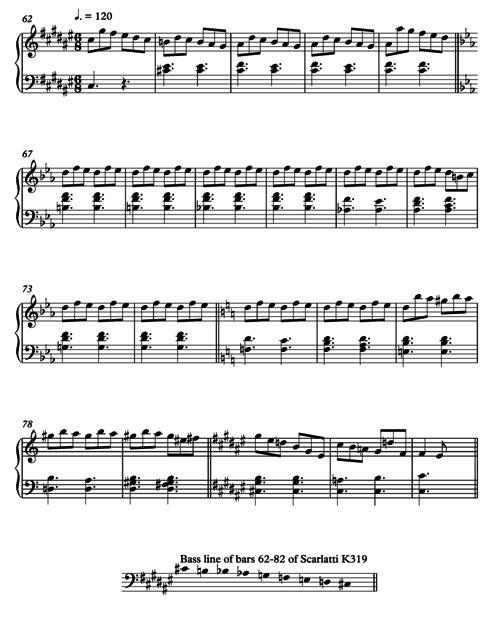
Taruskin (1996, 269) also cites the following bars from J. S. Bach's English Suite No. 3 as octatonic:

Langlé's 1797 harmony treatise contains a sequential progression with a descending octatonic bass, supporting harmonies that use all and only the notes of an octatonic scale (Langlé 1797, 72, ex. 25.2). In 1800, Beethoven composed his Piano Sonata No. 11 in B-flat, Op. 22. The slow movement of this work contains a passage of what was, for its time, highly dissonant harmony. In a lecture (2005), pianist András Schiff describes the harmony of this passage as "really extraordinary". The chord progressions at the beginning of the second and third bars of this passage are octatonic:
_from_Beethoven's_Piano_Sonata_Op.22%2C_bars_31-33.png)
Later in the 19th century, the notes in the chords of the coronation bells from the opening scene of Modest Mussorgsky's opera Boris Godunov, which consist of "two dominant seventh chords with roots a tritone apart" according to Taruskin (1996, 283), are entirely derived from an octatonic scale.
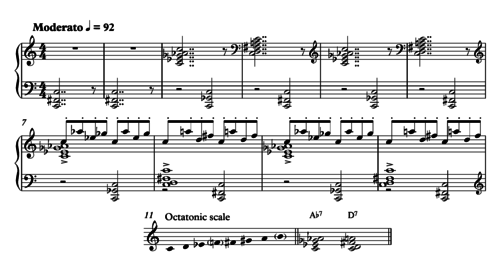
Taruskin continues: "Thanks to the reinforcement the lesson has received in some equally famous pieces like Scheherazade, the progression is often thought of as being peculiarly Russian" (Taruskin 1996, 283).
Tchaikowsky was also influenced by the harmonic and coloristic potential of octatonicism. As Mark DeVoto (2007, 144) points out, the cascading arpeggios played on the celesta in the "Sugar Plum Fairy" from the Nutcracker ballet are made up of dominant seventh chords a minor third apart.

“Hagens Watch”, one of the darkest and most sinister scenes in Richard Wagner’s opera Götterdämmerung features chromatic harmonies using eleven of the twelve chromatic notes, within which the eight notes of the octatonic scale may be found in bars 9–10 below:
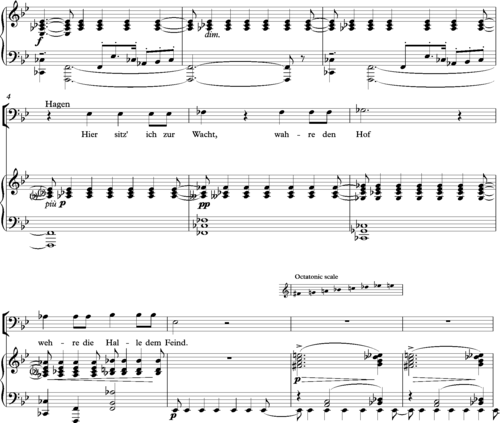
The scale also may be found in the music of Claude Debussy and Maurice Ravel. Melodic phrases that move by alternating tones and semitones frequently appear in the works of both these composers. Allen Forte (1991, 144–45) identifies a five-note segment in the cor anglais melody heard near the start of Debussy's "Nuages" from his orchestral suite Nocturnes as octatonic:

Mark DeVoto (2003, 183) describes "Nuages" as "arguably [Debussy's] boldest single leap into the musical unknown. 'Nuages' defines a kind of tonality never heard before, based on the centricity of a diminished tonic triad (B-D-F natural)." According to Stephen Walsh (2018, p137), the cor anglais theme "hangs in the texture like some motionless object, always the same and always at the same pitch." [1]
The scale was extensively used by Rimsky-Korsakov's student Igor Stravinsky, particularly in his Russian-period works such as Petrushka (1911), The Rite of Spring (1913), up to the Symphonies of Wind Instruments (1920). Passages using this scale are unmistakable as early as the Scherzo fantastique, Fireworks (both from 1908), and The Firebird (1910). It also appears in later works by Stravinsky, such as the Symphony of Psalms (1930), the Symphony in Three Movements (1945), most of the neoclassical works from the Octet (1923) to Agon (1957), and even in some of the later serial compositions such as the Canticum Sacrum (1955) and Threni (1958). In fact, "few if any composers have been known to employ relations available to the collection as extensively or in as varied a manner as Stravinsky" (Van den Toorn 1983, 42). The second movement of Stravinsky's Octet for wind instruments opens with what Stephen Walsh (1988, 127) calls "a broad melody completely in the octatonic scale". Jonathan Cross (2015, 144) describes a highly rhythmic passage in the first movement of the Symphony in Three Movements as "gloriously octatonic, not an unfamiliar situation in jazz, where this mode is known as the 'diminished scale', but Stravinsky of course knew it from Rimsky. The 'rumba' passage… alternates chords of E-flat7 and C7, over and over, distantly recalling the coronation scene from Mussorgsky's Boris Godunov. In celebrating America, the émigré looked back once again to Russia." Van den Toorn (1983) catalogues many other octatonic moments in Stravinsky's music. The scale also may be found in music of Alexander Scriabin and Béla Bartók. In Bartók's Bagatelles, Fourth Quartet, Cantata Profana, and Improvisations, the octatonic is used with the diatonic, whole tone, and other "abstract pitch formations" all "entwined… in a very complex mixture" (Antokoletz 1984, ). Mikrokosmos Nos. 99, 101, and 109 are octatonic pieces, as is No. 33 of the 44 Duos for Two Violins. "In each piece, changes of motive and phrase correspond to changes from one of the three octatonic scales to another, and one can easily select a single central and referential form of 8-28 in the context of each complete piece." However, even his larger pieces also feature "sections that are intelligible as 'octatonic music'" (Wilson 1992, 26–27).
Olivier Messiaen made frequent use of the octatonic scale throughout his career as a composer, and indeed in his seven modes of limited transposition, the octatonic scale is Mode 2. Peter Hill (1995, 73) writes in detail about "La Colombe" (The Dove), the first of a set of Preludes for piano that Messiaen completed in 1929, at the age of 20. Hill speaks of a characteristic "merging of tonality (E major) with the octatonic mode" in this short piece.
Other twentieth-century composers who used octatonic collections include Samuel Barber, Ernest Bloch, Benjamin Britten, Julian Cochran, George Crumb, Irving Fine, Ross Lee Finney, Alberto Ginastera, John Harbison, Aram Khachaturian, Witold Lutosławski, Darius Milhaud, Henri Dutilleux, Robert Morris, Carl Orff, Jean Papineau-Couture, Krzysztof Penderecki, Francis Poulenc, Sergei Prokofiev, Alexander Scriabin, Dmitri Shostakovich, Toru Takemitsu, Joan Tower (Alegant 2010, 109), Robert Xavier Rodriguez, and Frank Zappa (Clement 2009, 214). Other composers include Willem Pijper (Chan 2005, 52), who may have inferred the collection from Stravinsky's The Rite of Spring, which he greatly admired, and composed at least one piece—his Piano Sonatina No. 2—entirely in the octatonic system (Van den Toorn 1983, 464n11).
In the 1920s, Heinrich Schenker criticized the use of the octatonic scale, specifically Stravinsky's Concerto for Piano and Wind Instruments, for the oblique relation between the diatonic scale and the harmonic and melodic surface (Pople 1991, 2).
Harmonic implications
Jazz
Both the half-whole diminished and its partner mode, the whole-half diminished (with a tone rather than a semitone beginning the pattern) are commonly used in jazz improvisation, frequently under different names. The whole-half diminished scale is commonly used in conjunction with diminished harmony (e.g., the "Edim7" chord) while the half-whole scale is used in dominant harmony (e.g., with an "F![]()
Examples of octatonic jazz include Wayne Shorter's composition "Opus Pocus" from the album Pastorius (Pastorius 1976) and Herbie Hancock's piano solo on "Freedom Jazz Dance" from the Album Miles Smiles (1967).
Petrushka chord
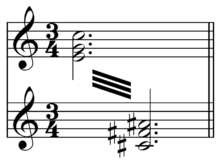
Bitonality
In Bartók's piano piece "Diminished Fifth," from Mikrokosmos, octatonic collections form the basis of the pitch content. In mm. 1–11, all eight pitch classes from the E♭ diminished scale (see Construction and Enumeration section) appear. In mm. 1–4, the pitch classes A, B, C, and D appear in the right hand, and the pitch classes E♭, F, G♭, and A♭ appear in the left hand. The collection in the right hand outlines the first four notes of an A minor scale, and the collection in the left hand outlines the first four notes of an E♭ minor scale. In mm. 5–11, the left and right hand switch—the A minor tetrachord appears in the left hand, and the E♭ minor tetrachord appears in the right hand.
From this, one can see that Bartók has partitioned the octatonic collection into two (symmetrical) four-note segments of the natural minor scales a tritone apart. Paul Wilson argues against viewing this as bitonality since "the larger octatonic collection embraces and supports both supposed tonalities" (Wilson 1992, 27).
Bartók also utilizes the two other octatonic collections so that all three possible octatonic collections are found throughout this piece (D♭, D, and E♭). In mm. 12–18 all eight pitch classes from the D♭ octatonic collection are present. The E♭ octatonic collection from mm. 1–11 is related to this D♭ octatonic collection by the following transposition operations: T, T4, T7, T10. In mm. 26–29, all eight pitch classes from the D octatonic collection appear. This collection is related to the E♭ octatonic collection from mm. 1–11 by the following transposition operations: T2, T5, T8, T11.
Other relevant features of the piece include the groups of three notes taken from the whole-half diminished scale in mm. 12–18. In these measures, the right hand features D♭, E♭, and G♭, the tetrachord without the 3rd (F). The left hand has the same tetrachord transposed down a tritone (G, A, C). In mm. 16, both hands transpose down three semitones to B♭, C, E♭ and E, G♭, A respectively. Later on, in mm. 20, the right hand moves on to A− and the left back to E♭−. After repeating the structure of mm. 12–19 in mm. 29–34 the piece ends with the treble part returning to A− and the bass part returning to E♭.
Alpha chord
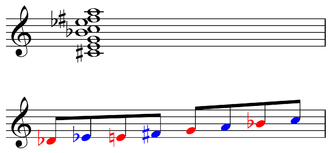
The alpha-chord (α chord) collection is, "a vertically organized statement of the octatonic scale as two diminished seventh chords," such as: C♯–E–G–B♭–C–E♭–F♯–A (Wilson 1992, 7). Forte number: 4-17.
One of the most important subsets of the alpha collection, the alpha chord (such as E–G–C–E♭ ![]()
Beta chord
The beta chord (β chord) is a five-note chord, formed from the first five notes of the alpha chord (integers: 0,3,6,9,11 (Honti 2007, 305); notes: C♯, E, G, B♭, C♮). The beta chord can also occur in its reduced form, that is, limited to the characteristic tones (C♯, E, G, C♮ and C♯, G, C♮). Forte number: 5-31B.
The beta chord may be created from a diminished seventh chord by adding a diminished octave. It may be created from a major chord by adding the sharpened root (solfege: in C, di is C♯: C♯, E, G, C♮) ( 1977, 12).
Gamma chord
The gamma chord (γ chord) is 0,3,6,8,11 (Forte number 5-32A ![]()
See also
References
- ↑ Walsh, S. (2018, p.137) Debussy, a Painter in Sound. London, Faber.
- (1977). Soundings, Volumes 6-9, p.12. University College.
- Agmon, Eytan (1990). "Equal Divisions of the Octave in a Scarlatti Sonata." In Theory Only 11, no. 5:1-8.
- Alegant, Brian (2010). The Twelve-Tone Music of Luigi Dallapiccola. ISBN 978-1-58046-325-6.
- Antokoletz, Elliott (1984). The Music of Béla Bartók: A Study of Tonality and Progression in Twentieth-Century Music. Berkeley and Los Angeles: University of California Press. Cited in Wilson directly above. ISBN 0-520-06747-9.
- Baur, Steven (1999). "Ravel's 'Russian' Period: Octatonicism in His Early Works, 1893–1908." Journal of the American Musicological Society 52, no. 1:.
- Berger, Arthur (1963). "Problems of Pitch Organization in Stravinsky". Perspectives of New Music 2, no. 1 (Fall–Winter): 11–42.
- Campbell, Gary (2001). Triad Pairs for Jazz: Practice and Application for the Jazz Improvisor. ISBN 0-7579-0357-6.
- Chan, Hing-yan (2005). New Music in China and the C.C. Liu Collection at the University of Hong Kong. ISBN 9789622097728.
- Cohn, Richard (1991). "Bartók's Octatonic Strategies: A Motivic Approach." Journal of the American Musicological Society 44.
- Cross, Jonathan (2015). Igor Stravinsky. London: Reaction Books.
- DeVoto, Mark (2003). "The Debussy Sound: Colouyr, Texture, Gesture". In The Cambridge Companion to Debussy, edited by Simon Tresize, 179–96. Cambridge Companions to Music. Cambridge and New York: Cambridge University Press. ISBN 0-521-65243-X (cloth); ISBN 0-521-65478-5 (pbk).
- DeVoto, Mark (2007) "Boris's Bells, by Way of Schubert and Others". Current Musicology, no. 83 (Spring): ..
- Forte, Allen (1991). "Debussy and the Octatonic". Music Analysis 10, nos. 1–2 (March–July): 125–69.
- Frazzi, Vito (1930). Scale alternate per pianoforte con diteggiature di Ernesto Consolo. Florence: A. Forlivesi.
- Gillespie, Robert (2015). "Herbie Hancock: Freedom Jazz Dance Transcription". (Accessed 1 October 2015).
- Hatfield, Ken (2005). Mel Bay Jazz and the Classical Guitar Theory and Applications. ISBN 0-7866-7236-6.
- Hill, Peter (1995). The Messiaen Companion. London: Faber and Faber.
- Honti, Rita (2007). Principles of pitch organization in Bartók's Duke Bluebeard's Castle. University of Helsinki. ISBN 9789521038372.
- Kahan, Sylvia (2009). In Search of New Scales: Prince Edmond de Polignac, Octatonic Explorer. Rochester, NY: University of Rochester Press. ISBN 978-1-58046-305-8.
- Keeling, Andrew (2007). King Crimson: Red: An Analysis by Andrew Keeling.
- Kholopov, Yuri (2003). Harmony. Theoretical Course. Orig. title: Гармония. Теоретический курс. Moscow: Lan'.
- Kholopov, Yuri (1982). "Modal harmony. Modality as a type of harmonic structure". Art of Music. General Questions of Music Theory and Aesthetics: 16–31; Orig. title: Модальная гармония: Модальность как тип гармонической структуры // Музыкальное искусство. Общие вопросы теории и эстетики музыки. Ташкент: Издательство литературы и искусства им. Г. Гуляма
- Langlé, Honoré François Marie (1797). Traité d'harmonie et de modulation. Paris: Boyer.
- Lendvai, Ernő (1971). Béla Bartók: An Analysis of his Music. introd. by Alan Bush. London: Kahn & Averill. ISBN 0-900707-04-6. OCLC 240301. Cited in Wilson (1992).
- Pastorius, Jaco (1976). "Opus Pocus". Spotify.com (accessed 1 October 2015).
- Pople, Anthony (1991). Berg: Violin Concerto. Cambridge and New York: Cambridge University Press. ISBN 0-521-39976-9.
- Rimsky-Korsakov, Nicholas (1935). My Musical Life, translated by Judah A. Joffee. New York: Tudor.
- Sanguinetti, Giorgio (1993). "Il primo studio teorico sulle scale octatoniche: Le 'scale alternate' di Vito Frazzi." Studi Musicali 22, no. 2:
- Schiff, Andras (2006). "Untitled lecture". The Guardian TV (16 November; accessed 1 October 2015).
- Schillinger, Joseph (1946). The Schillinger System of Musical Composition, Vol. 1: Books I–VII, edited by Lyle Dowling and Arnold Shaw. New York: Carl Fischer.
- Schuijer, Michiel (2008). Analyzing Atonal Music: Pitch-Class Set Theory and Its Contexts. ISBN 978-1-58046-270-9.
- Slayton, Michael K. (2010). Women of Influence in Contemporary Music: Nine American Composers. ISBN 9780810877481.
- Taruskin, Richard (1985). "Chernomor to Kashchei: Harmonic Sorcery; or, Stravinsky's 'Angle'". Journal of the American Musicological Society 38, no. 1 (Spring): 72–142.
- Taruskin, Richard (1987). "Chez Pétrouchka- Harmony and Tonality "chez" Stravinsky". 19th-Century Music 10, no. 3 (Spring, Special Issue: Resolutions I): 265–86.
- Taruskin, Richard (1996) Stravinsky and the Russian Traditions. Oxford and New York: Oxford University Press.
- Tymoczko, Dmitri (2002). "Stravinsky and the Octatonic: A Reconsideration". Music Theory Spectrum 24, no. 1 (Spring): 68–102.
- Van den Toorn, Pieter (1983). The Music of Igor Stravinsky. New Haven and London: Yale University Press. ISBN.
- Walsh, Stephen (1988). The Music of Stravinsky. London: Routledge.
- Wollner, Fritz (1924) "7 mysteries of Stravinsky in Progression" 1924 German international school of music study.
- Wilson, Paul (1992). The Music of Béla Bartók. ISBN 0-300-05111-5.
- Yavorsky, Boleslav Leopoldovich (1911). "Neskol'ko myslei v sviazi s iubileem Frantsa Lista". Muzyka no. 45 (8 October): 961. Cited in Taruskin (1985, 113).